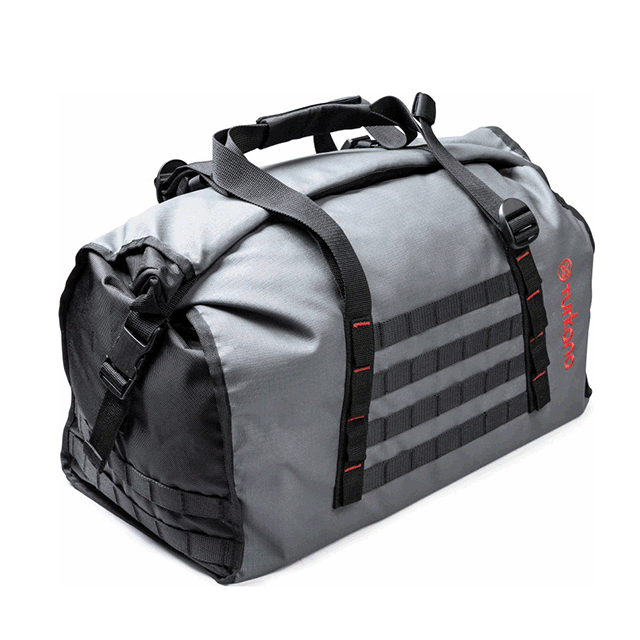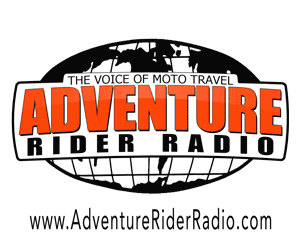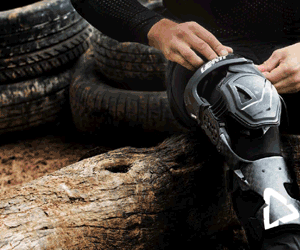“I get pretty romantic about motorcycle travel and am constantly having visions about what I want to do, or where I want to go. When I am traveling by myself, I find that I can fulfill those dreams, because I can be light enough on my feet to make it happen. But with more than one person it is tough to make plan changes quickly, and so you end up doing what you had planned well in advance, even if that is no longer relevant. Overland travel is very uncertain, and I think people find a lot of comfort in plans, and sticking to those plans helps to fill this great unknown with structure. I like to embrace that uncertainty and fill it up with whatever comes to mind, or whatever I am influenced by. Fighting uncertainty with greater uncertainty!” – Adam Lyman

“I rode my first motorcycle when I was seventeen. A friend of mine had a dad who rode motorcycles, and one day my friend asked me if I wanted to come and learn how to ride. Of course, I jumped at the idea and drove out to his dad’s garage where a bunch of bikes was parked. He took out a 1985 Honda Nighthawk 450, and we wheeled it over to the empty neighboring subdivision. My friend briefly explained the controls, then stepped back to let me take a shot at it. It was getting late in the day, and a soft golden light made the winding, unfinished suburban road in front of me glow. So I threw my leg over, revved the throttle, pulled in the clutch, banged down into first gear and off I went. I had never experienced a feeling quite like this before; it was pure ecstasy. I felt like I was flying. When I got back to my friend, I could barely talk. I just smiled and shook my head in disbelief of the experience.”

“For me, motorcycles were a natural discovery, and once discovered, I knew immediately that I had to have one, but I faced a lot of opposition from my parents. Unfortunately for them, I was a seventeen-year-old boy in love, and there wasn’t much anyone could do to stop me from getting one. The rest of my seventeenth year, I sat twiddling my thumbs in high school classrooms dreaming and dreaming, about that midnight blue Honda Nighthawk. So I came up with a plan. On the day of my eighteenth birthday, I leveraged my adult powers and marched straight over to my friend’s house. I bought that old Nighthawk for a $1000, registered and insured it under my name all within a few hours. Later that day I was riding my first motorcycle. All unbeknownst to my parents mind you, and the rest is history!”

“Three years later, I met Jesse Gamble, also an avid motorcycle enthusiast, during my first college internship. He kept asking me; ‘have you seen that documentary about Obi-Wan riding around the world?’ At that time, I only thought there were two kinds of motorcycles, road bikes, and dirt bikes. I’d spent years working myself into the road biking community even though I grew up driving old Jeeps around the trails in northern Michigan. I didn’t know that my love for motorcycles and off-road driving could be combined into one activity. So, one evening after work I finally took Jesse’s advice and watched an episode of Obi-Wan’s documentary, also known as “Long Way Round.” Within the first ten minutes, I thought to myself; “I am 100% doing this.” I was hooked on adventure riding. I felt exactly the way I felt the first time on that old Nighthawk several years earlier. I binge watched the rest of the Long Way Round episodes, immediately followed by the Long Way Down.”

“I’m a sucker for old, classic Japanese, mostly Honda, bikes. I fell in love early with Hondas, and there’s something about that first love that makes it hard to get on another type of motorcycle. Honda bikes, specifically those pre-1996 have some real soul to them, which I’m convinced modern motorcycles have now lost. To me, an old bike is like a representation of that mysticism and nostalgia, when overlanding by motorcycle was new and unheard of. When adventure motorcycling was not an industry segment, it was just regular people pushing the limits of themselves and their vehicles. Given my position, I’ve naturally dreamt of owning an Africa Twin for as long as I found out they existed. But as much as I wanted one, I knew hardly anything about them other than what I could dig up on the internet, which surprisingly, isn’t a lot. They were not sold in the US, so I had never ridden one, or known anyone that had one who could tell me something about it.”

“I bought the bike with 50 000 mi / 80 000 km on it. It looked clean and not abused, so I figured it was a good candidate for a rebuild. After I’d brought it ‘home’ I started by taking the entire front end apart. I have some experience building adventure bikes, so I started with the basics, and then things started to escalate as I found more and more systems that needed attention.” Working from the Woodstock Moto Co in Cape Town, Adam cleaned and overhauled the entire air-filtration and carburation system along with a myriad of hoses and seals. The wiring loom got a check, and previous ‘upgrades’ were remedied with the correct installation. Both the rectifier and starter relay were also replaced.

He also rebuilt the wheels with new bearings and seals along with replacing the rusted neck bearings. Steering and controls were upgraded with Renthal Enduro High bars, aluminum spacers for the top triple clamp, two-inch rise handlebar clamps, replaced cables, Barkbuster hand guards and a set of new grips. Auxiliary parts include a Scorch Exhaust, Hepco Becker crash bars, a new vinyl seat cover, aftermarket center stand, Powerbronze short screen and luggage racks with mounted tool tubes. The suspension was also completely overhauled by Martin of MP Custom Valve in Cape Town. “Amongst other things Martin advised me to replace the smaller top spring in the forks with a spacer to stiffen the overall spring rate of the front suspension. He also supplied me with two replica Race Tech cartridge emulators, and hooked me up with a new, stiffer Ohlins spring for the rear. He also rebuilt the original rear shock with fresh oil, seals and gas. Then Martin drilled and tapped in a Schrader valve on the back of the shock’s gas chamber. So if I was ever running low on gas ‘in the bush,’ I could hook up my bicycle pump to the valve to re-pressurize the chamber.”

“After having a hard-case set-up, I now exclusively run soft bags. I primarily ride dirt, and soft bags are lighter, cheaper, and much better for dirt riding. I prefer soft luggage that requires as little luggage racks or mounts as possible. For aggressive off-road trips, I take Wolfman Enduro Dry bags to travel light without a luggage rack. But on this trip, I used two 9.2 gal / 35 l Badger Pannier Bags made in South Africa, with the Mosko Moto Backcountry 40 top bag to complete the setup. Lastly, I carry the Giant Loop Zigzag handlebar bag wherever I go for the small essentials along with a Flying Brick Fuel Cell to up fuel range. I don’t use a tank bag, or other auxiliary bags because I don’t need them, and they tend to get in the way. There must be some law that states you will fill whatever storage capacity you give yourself!”

“There are so many future things that I would like to do to the bike. That’s my problem with builds; they are never done. Since the engine is the only remaining untouched system on the bike needing attention, I will tackle it. After that, I have plans to add some serious fuel capacity to the bike so I can explore the wilderness of a place by riding through its most rural roads. I plan to add a 9.5 gal / 36 l front fuel tank along with an additional 4.5 gal / 17 l rear tank. I’ll also add a new one-piece fairing for the front along with getting the custom bike people in Cape Town to paint or vinyl the whole thing in retro Africa Twin colors. Finally, I’d like to put a full Arrow exhaust system on, and maybe play with different carburetor options. Then the bike might be done…”

“I had made it to Rundu, Namibia, which is a small frontier town near the border of Angola. I filled up with petrol and walked inside to grab some lunch from the gas station shop. I came out, and there was a large pool of liquid coming from under my bike. Now, at gas stations, I never assume that the puddle is mine because it’s quite easy to find yourself parked over someone else’s puddle. I didn’t panic straight away, because besides, what could that puddle be? Lunch in hand, I walk over to my bike and looked at the side of the engine to examine the situation further and saw gas quirting out of a pin-sized hole in my tank. I exclaimed in profanity. I couldn’t believe it. I had experienced all kinds of motorcycle problems, but a gas leak from a hole in the petrol tank had never been one of them. As with most emergency break downs while on the road, I felt the anxiety flooding in, and the world around me slowly starting to turn upside down. Part of me was still in shock at this freak problem, most of me was pissed at the bike, and the rest of me was wondering what I was going to do about it. I was in a small town, in the middle of nowhere, with little Western influence. I looked up at the sky, and several dark, foreboding clouds were coming in from the south. At that moment I felt this attack of anxiety. I was in a pretty foreign place, a busy frontier town I didn’t know or want to be in and knew no one there that could help me.”

“I finished my lunch and tried to calm myself down. After all, I decided I was in a town with enough services, with plenty of people to help me, and I had the tools I needed to do the job. A tire shop next to the petrol station proved to be the best spot, and I took the bike apart outside under a small roof. Pretty soon I had an audience of tire shop workers as I mixed up the JB weld and patched the hole. I was feeling much better now, knowing that the problem would be solved as soon as the epoxy dried. Except that would take several hours for a full cure. That meant I was stuck in town for the night without transportation. At some point during the fiasco, the manager of the tire shop came out to see what was going on. He was a goofy Afrikaans guy and turned out to be exactly the help I needed. There was a lodge nearby on the river that borders Namibia and Angola, run by one of his friends. So, he called the owner for me, reserved a campsite and volunteered to drive me the 20 kilometers out to the site. We rolled the bike into the shop where it would sleep for the night, and then packed all my gear into the truck. Both he and the owner of the lodge were incredibly helpful, and I had a lovely afternoon relaxing by the river, drinking tea and listening to the rain come in that evening. What started as a disastrous afternoon gave way to a nice relaxing evening, complete with a hot shower and meal!”

For more on Adam’s adventure follow his Instagram page.
All images copyright Adam Lyman.





wow, great story adam. you have a gift as a writer also. did you know? i suppose when you have a passion, the thoughts just flow. the pictures are also amazing, but im concerned about the lack of trees. are you on mars? also, those dirt roads look better than our paved roads. please find out why and then call the governor. safe travels!
Adam
Great article! I can see a book in your future and would like an autographed copy please. Keep the photos and stories coming. Hope to connect soon. Be well!
Great article I have never driven a motorcycle but I ready to get one. If you return to MSU forget engineering, sustainability etc and enroll in creative writing. Your dreamer instincts will serve you well.